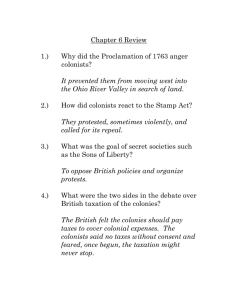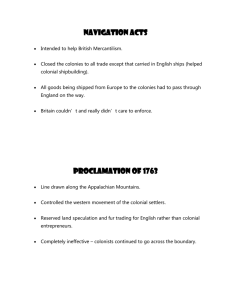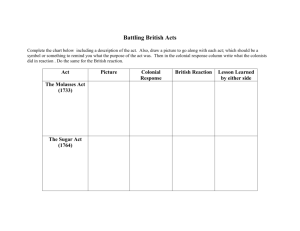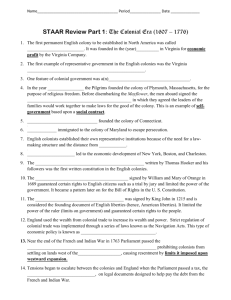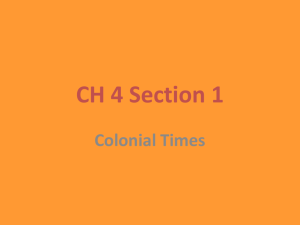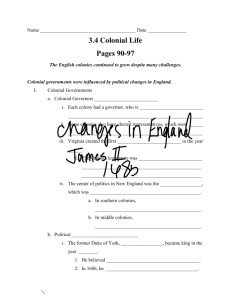Events Leading To The American Revolution
advertisement
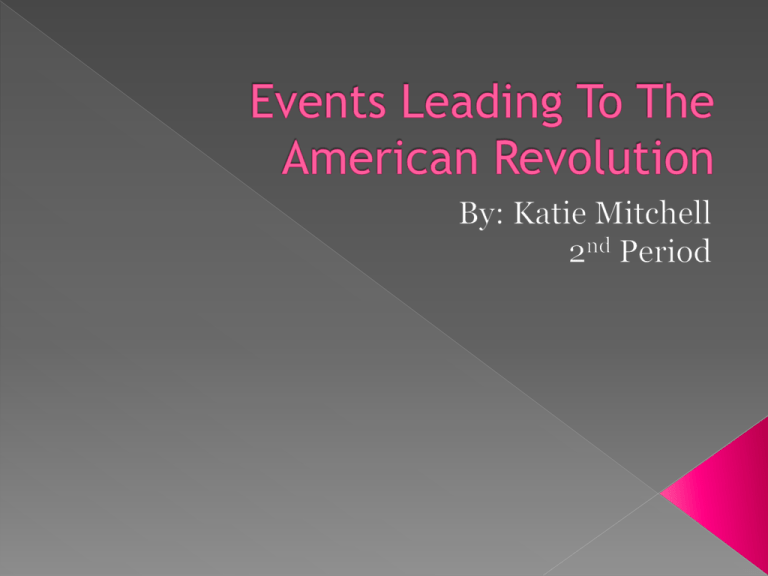
Date 1650-1700’s What it did It directed the flow of goods between England and the colonies. Colonial merchants who had goods to send to England could not use foreign ships. Even if those ships offer cheaper rates. They also prevented the colonists from sending certain products, such as sugar or tobacco, outside England’s empire. Colonial Response Some colonist ignored these laws and began smuggling. Controls on trade would later cause even more conflict between the American colonies and England. Date 1763 What it did It declared that the Appalachian Mountains were western boundary for the colonies. The proclamation acknowledged that Native Americans owned the lands on which they were then residing. White settlers in the area were to be removed. Colonial Response Although the end of the French and Indian War brought peace for the first time in many years, the Proclamation created friction. More conflicts would soon arise between Britain and the colonies in north America Date 1765 What it did Placed a tax on almost all printed material in the colonies-everything from newspapers and pamphlets to wills and playing cards. All printed materials had to have a stamp, which was applied by British officials. Because so many items were taxed , it affected almost everyone in the colonial cities. Colonial Response Patrick Henry persuaded the Virginia House of Burgesses to take action against the Stamp Act. The Sons of liberty took to the streets to protest the Stamp Act. Date 1765 What it did The Sons of Liberty were colonial patriots fighting for freedom who sometimes hurt and killed innocent people. Some of their tactics were the same as terrorists. Not only did the Sons of Liberty oppose the Stamp Act, they also were involved in causing rebellion during the Townshend Acts and the Tea Act Colonial Response People in other cities also organized Sons of Liberty groups. Throughout the summer of 1765, protesters burned effigies representing unpopular tax collectors. Date 1765 What it did The Stamp Act was Repealed and Parliament passed the Declaratory Act. Which stated that Parliament had the right to tax the colonies “in all cases whatsoever”. They also had the right to make decisions for the colonies. Colonial Response Although many in Parliament felt that taxes were implied in this clause, some other Parliament members and many of the colonialists did not. Many of the colonists were busy celebrating their political victory to notice that the Declaratory Act. Date 1765 What it did Parliament passed the Quartering Act to address the practical concerns of such a troop deployment. Colonial Response The cost of expenses for an army was no small matter for the colonial assemblies. In the past when an attack by a foreign power was imminent, they usually responded with the necessary appropriations. In the mid-1760s most colonists no longer feared the French. Many had concluded that the soldiers were present for the purpose of assuring American compliance with unpopular programs drafted in England. Date 1776 What it did Parliament passed a set of laws that taxed only imported goods. The goods, however, included basic itemssuch as glass, tea, paper, and lead-that the colonists had to import because they did not produce them. Colonial Response By this time the colonists were outraged by any taxes Parliament passed. They believed that only their representatives had the right to levy taxes on them. The colonists responded by bringing back the boycott that had worked so well against the Stamp Act. The boycott proved to be even more widespread this time. Date 1770 What it did A fight broke out between townspeople and soldiers. The angry townspeople moved through the streets, picking up any weapons they could find. They pushed forward toward the customshouse on King Street. As the crowd approached, the sentry on duty panicked and called for help. The crowd responded by throwing things. “Fire you bloodybacks, you lobsters,” the crowd screamed. “You dare not fire.” After one of the soldiers was knocked down the nervous and confused redcoat did fire. Several shots rang out, killing five colonists. Colonial Response Colonial leaders used news of the killings as propaganda against the British. Samuel Adams put up posters describing the “Boston Massacre” as a Slaughter of innocent Americans by bloodthirsty redcoats. An engraving by Paul Revere’s powerful image strengthened antiBritish feelings. Date 1773 What it did The tea act gave the East India Company the right to ship tea to the colonies without paying most of the taxes usually placed on tea. It also allowed the company to bypass colonial merchants and sell its tea directly to shopkeepers at a low price. On December 16, a group of men disguised as Mohawks and armed with hatchets marched to the wharves. At midnight they boarded the ships and threw 342 chests of tea overboard. An event that became known as the Boston Tea Party. Colonial Response Word of this act of defiance spread throughout the colonies. Men and women gathered in the streets to celebrate the bravery of the Boston Sons of Liberty. Date 1774 What it did The Coercive Acts were very harsh laws intended to punish the people of Massachusetts for their resistance. They closed the Boston Harbor until the Massachusetts colonists paid for the ruined tea. This Action prevented the arrival of food and other supplies that normally came by ship. It also took away certain rights of the Massachusetts colonists. Colonial Response Parliament planned to isolate Boston with these acts. Instead the other colonies sent food and clothing to demonstrate their support for Boston. The colonists maintained that the Coercive Acts violated their right as English citizens. These including the rights to no quartering of troops in private homes and no standing army in peacetime without their consent.

